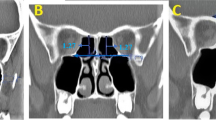Abstract
Purpose
Understanding the anatomy of the paranasal sinuses and their variations is essential to achieving safe and effective endoscopic sinus surgery. The ethmomaxillary sinus (EMS) is a relatively under-researched anatomical variation. This study investigated the prevalence, clinical features, and effect of EMS on the maxillary sinus in comparison with Haller’s cells.
Methods
Patients who visited the Rhinology Clinic at our hospital for rhinologic symptoms between January 2020 and December 2020. Computed tomography (CT) scans of paranasal sinuses were obtained at 1 mm-section thickness. Using CT scans, we investigated the clinical features of EMS, measured maxillary sinus volume, and analyzed the presence of maxillary sinusitis.
Results
EMS was observed in 26 of the 250 patients (10.4%). The male-to-female ratio was equal. The age ranged from 18 to 83 years (mean age, 56.3). Of the patients with EMS, 65.4% were unilateral and 34.6% were bilateral. The prevalence of Haller’s cells was similar to that in EMS (10.8%). In the analysis of patients with unilateral EMS, the EMS side was found to have a significantly reduced maxillary sinus volume compared to the opposite side, whereas the difference was not significant in Haller’s cells. There was no significant relationship between EMS or Haller’s cells and maxillary sinusitis.
Conclusions
EMS can significantly affect maxillary sinus volume. Therefore, surgeons should thoroughly review PNS CT scans before paranasal sinus surgery to determine the presence and features of EMS.




Similar content being viewed by others
Data availability
The data sets generated and analyzed during the current study are available from the corresponding author upon reasonable request.
Change history
09 October 2023
A Correction to this paper has been published: https://doi.org/10.1007/s00405-023-08266-5
References
Bolger W. Anatomy of the paranasal sinuses. Diseases of the sinuses: diagnosis and management: Decker, Hamilton; 2001. p 1–22.
Polavaram R, Devaiah AK, Sakai O, Shapshay SM (2004) Anatomic variants and pearls–functional endoscopic sinus surgery. Otolaryngol Clin North Am 37(2):221–242
Bayram M, Sirikci A, Bayazıt YA (2001) Important anatomic variations of the sinonasal anatomy in light of endoscopic surgery: a pictorial review. Eur Radiol 11(10):1991–1997
Zhang L, Han D, Ge W, Tao J, Wang X, Li Y et al (2007) Computed tomographic and endoscopic analysis of supraorbital ethmoid cells. Otolaryngol Head Neck Surg 137(4):562–568
Peter JW (2003) The agger nasi cell: the key to understanding the anatomy of the frontal recess. Otolaryngol Head Neck Surg 129(5):497–507
Caversaccio M, Boschung U, Mudry A (2011) Historical review of Haller’s cells. Ann Ant 193(3):185–190
Jinfeng L, Dai Jinsheng WX, Yanjun W, Ningyu W (2017) The pneumatization and adjacent structure of the posterior superior maxillary sinus and its effect on nasal cavity morphology. Med Sci Monit 23:4166
Khanobthamchai K, Shankar L, Hawke M, Bingham B (1991) Ethmomaxillary sinus and hypoplasia of maxillary sinus. J Otolaryngol 20(6):425–427
Kuan EC, Clair JM-S, Frederick JW, Tajudeen BA, Wang MB, Harvey RJ et al (2016) Significance of undissected retromaxillary air cells as a risk factor for revision endoscopic sinus surgery. Am J Rhinol Allergy 30(6):448–452
Şirikçi A, Bayazıt YA, Bayram M, Kanlıkama M (2004) Ethmomaxillary sinus: a particular anatomic variation of the paranasal sinuses. Eur Radiol 14(2):281–285
Ozcan KM, Selcuk A, Oruk V, Sarikaya Y, Dere H (2008) Ethmomaxillary sinus. Eur Arch Otorhinolaryngol 265(2):185–188
Liu J, Dai J, Wen X, Wang Y, Zhang Y, Wang N (2018) Imaging and anatomical features of ethmomaxillary sinus and its differentiation from surrounding air cells. Surg Radiol Anat 40(2):207–215
Funding
The author(s) received no financial support for the research, authorship, and/or publication of this article.
Author information
Authors and Affiliations
Contributions
SJ Kim and HM Lee contributed to the conception and design of the study; SJ Kim and JW Moon performed the experiments, collected and analyzed data; SJ Kim and HM Lee wrote the manuscript; SJ Kim and HM Lee revised the manuscript. All authors reviewed and approved the final version of the manuscript.
Corresponding author
Ethics declarations
Conflict of interest
The author(s) declared no potential conflicts of interest concerning the research, authorship, and/or publication of this article.
Ethical approval
The study protocol was approved by the Ethics Committee of Korea University Guro Hospital.
Additional information
Publisher's Note
Springer Nature remains neutral with regard to jurisdictional claims in published maps and institutional affiliations.
Rights and permissions
Springer Nature or its licensor (e.g. a society or other partner) holds exclusive rights to this article under a publishing agreement with the author(s) or other rightsholder(s); author self-archiving of the accepted manuscript version of this article is solely governed by the terms of such publishing agreement and applicable law.
About this article
Cite this article
Kim, SJ., Moon, J.W. & Lee, HM. Clinical and imaging features of ethmomaxillary sinus compared to Haller’s cell. Eur Arch Otorhinolaryngol 280, 5401–5406 (2023). https://doi.org/10.1007/s00405-023-08148-w
Received:
Accepted:
Published:
Issue Date:
DOI: https://doi.org/10.1007/s00405-023-08148-w




